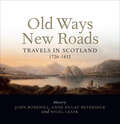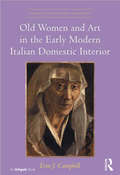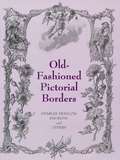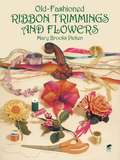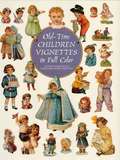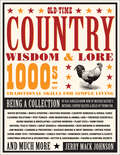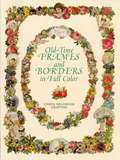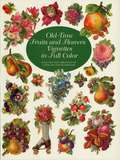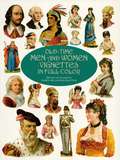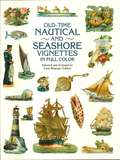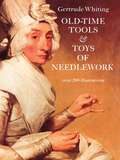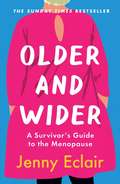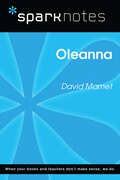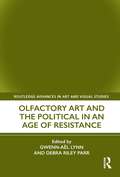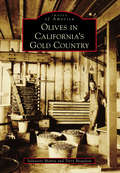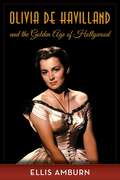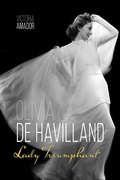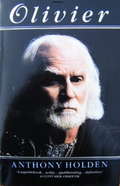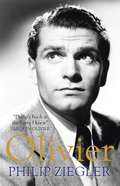- Table View
- List View
Old Waterfront Walls: Management, maintenance and rehabilitation
by R.N. Bray P.F.B. TathamThis book provides comprehensive guidance on maintaining old waterfront structures, particularly gravity walls constructed with stone masonry, brick, blocks or mass concrete. It will be valuable for all engineers responsible for such structures.
Old Ways New Roads: Travels in Scotland, 1720–1832
by John Bonehill, Anne Dulau Beveridge and Nigel LeaskIn 1725 an extensive military road and bridge-building programme was implemented by the British crown that would transform 18th-century Scotland. Aimed at pacifying some of her more inaccessible regions and containing the Jacobite threat, General Wade’s new roads were designed to replace ‘the old ways’ and ‘tedious passages’ through the mountains. Over the next few decades, the laying out of these routes opened up the country to visitors from all backgrounds. After the 1760s, soldiers, surveyors and commercial travellers were joined by leisure tourists and artists, eager to explore Scotland’s antiquities, natural history and scenic landscapes, and to describe their findings in words and images. In this book a number of acclaimed experts explore how the Scottish landscape was variously documented, evaluated, planned and imagined in words and images. As well as a fascinating insight into the experience of travellers and tourists, it also considers how they impacted on the experience of the Scottish people themselves.
Old Women and Art in the Early Modern Italian Domestic Interior (Visual Culture in Early Modernity)
by Erin J. CampbellThough portraits of old women mediate cultural preoccupations just as effectively as those of younger women, the scant published research on images of older women belies their significance within early modern Italy. This study examines the remarkable flowering, largely overlooked in portraiture scholarship to date, of portraits of old women in Northern Italy and especially Bologna during the second half of the sixteenth century, when, as a result of religious reform, the lives of women and the family came under increasing scrutiny. Old Women and Art in the Early Modern Italian Domestic Interior draws on a wide range of primary visual sources, including portraits, religious images, architectural views, prints and drawings, as well as extant palazzi and case, furnishings, and domestic objects created by the leading artists in Bologna, including Lavinia Fontana, Bartolomeo Passerotti, Denys Calvaert, and the Carracci. The study also draws on an array of historical sources - including sixteenth-century theories of portraiture, prescriptive writings on women and the family, philosophical and practical treatises on the home economy, sumptuary legislation, books of secrets, prescriptive writings on old age, and household inventories - to provide new historical perspectives on the domestic life of the propertied classes in Bologna during the period. Author Erin Campbell contends that these images of unidentified women are not only crucial to our understanding of the cultural operations of art within the early modern world, but also, by working from the margins to revise the center, provide an opportunity to present new conceptual frameworks and question our assumptions about old age, portraiture, and the domestic interior.
Old-Fashioned Pictorial Borders
by others Charles Francois Daubigny60 rare plates of pictorial borders -- all with space for text or a message -- depict floral garlands, cupids, scrollwork, as well as finely rendered scenes of salon parties, amorous couples, ardent suitors, lovely maidens, and other eye-catching vignettes. Superb royalty-free illustrations for artists, graphic designers, decoupeurs, and other craftworkers.
Old-Fashioned Ribbon Trimmings and Flowers
by Mary Brooks PickenThe art of fashioning decorative accents with ribbons is enjoying a revival among today's crafters, who find it the perfect way to add lovely touches to clothing, personal items, household accessories, and more.Reproduced from a rare vintage edition, this profusely illustrated how-to book describes how to fold and sew lengths of ribbon to create dramatic ruffles, bows, and bands. You'll also learn how to use ribbon to fashion appealing florals; daisies, chrysanthemums, rosebuds, violets, petunias, dahlias, sunflowers, and even complete bouquets. Then use these charming ribbon creations to trim a hat, decorate baby clothes and lingerie, add a luxurious touch to lampshades and cushions, or embellish shoes, baby carriages, blankets, coat hangers, and much more.Step-by-step instructions show you exactly how to proceed. No special talent, other than minimal sewing skill, is required to learn ribbon art techniques and experience the satisfaction of creating an attractive item for yourself, your home, or a special someone.
Old-Time Children Vignettes in Full Color (Dover Pictorial Archive)
by Carol Belanger GraftonHandsome collection of 358 vignettes depicting Victorian-era youngsters singly and in pairs, outfitted in knee pants, high-top boots and ruffled dresses; carrying flowers and baskets of fruit, playing croquet and other games, cuddling animals, and much more. Splendid sourcebook for hobbyists; engaging royalty-free images for artists and designers.
Old-Time Country Wisdom & Lore: 1000s of Traditional Skills for Simple Living
by Jerry Mack JohnsonA grand encyclopedia of country lore by famed Texas folklorist Jerry Mack Johnson, covering water witching, maple syruping, weather wisdom, country remedies and herbal cures, cleaning solutions, pest purges, bird migrations and animal lore, firewood essentials, adobe making and bricklaying, leather working, plant dyes, farm foods, natural teas and tonics, granola, bread making, beer brewing and winemaking, jams and jellies, canning and preserving, sausage making and meat smoking, drying foods, down-home toys, papermaking, candle crafting, homemade soaps and shampoos, Christmas wreaths and decorations, butter and cheese making, fishing and hunting secrets, and much more.
Old-Time Frames and Borders in Full Color
by Carol Belanger GraftonCharming collection of 12 full-page and 24 half-page frames features colorful collages of flowers, cherubs, butterflies, heart-felt messages, and more. Compiled from rare Victorian-era materials, the lovely royalty-free borders will add a special old-time touch to assorted graphics projects, but will also be ideal for accenting photos and other collectibles.
Old-Time Fruits and Flowers Vignettes in Full Color
by Carol Belanger GraftonOver 300 superbly engraved images of nature's lovely offerings: dainty sprays of roses, poppies, daisies, forget-me-nots, and other blooms; as well as branches heavily laden with apples, peaches, plums, grapes, pears and more fruit. An affordable collection of royalty-free illustrations for immediate use in art and craft projects.
Old-Time Men and Women Vignettes in Full Color
by Carol Belanger GraftonIn this collection of rare, turn-of-the-century images, you'll find many different kinds of people from a variety of historical periods. Among its 304 images, this book contains pictures of men and women both in realistic everyday dress, and resplendent in fine jewels and clothing. Other illustrations portray amusing caricatures of people with outlandish and comical distortions. In addition to several portraits of well-known celebrities such as Shakespeare, Lincoln, and Michelangelo, this book also includes vignettes depicting a knight in full body armor and ladies riding sidesaddle on horses, as well as many images of people playing musical instruments. Collecting these chromolithographs was a popular hobby in the Victorian era, and the vivid colors in these antique cuts continue to charm and inspire artists and designers today.
Old-Time Nautical and Seashore Vignettes in Full Color (Dover Pictorial Archive)
by Carol Belanger GraftonThis handsome collection of full-color vignettes, painstakingly culled from rare 19th- and early-20th-century chromolithographs, is the perfect resource for countless arts and crafts projects that require a maritime touch. Featured are 323 exquisite full-color illustrations of sailors, ships, rowboats, lighthouses, swimmers, fish, shells, and other nautical motifs in a great variety of sizes, shapes, and styles.Graphic artists, designers, découpeurs, and collagists will find these superb copyright-free illustrations ideal for scores of projects with a maritime theme. Printed one side only on acid-free paper (with acid-free-inks), these nostalgic designs are also ideal for use in scrapbooks, memory albums, and other treasured collections.
Old-Time Tools & Toys of Needlework
by Gertrude WhitingIt was quite fashionable among the ladies of Marie Antoinette's court to employ stilettos and punches for parfilage. They unpicked the gold and silver threads from the richly embroidered material of their gowns and cloaks. A set of bone bobbins was found in England with the Lord's Prayer spirally incised phrase by phrase along each bobbin's length. A clever French inventor designed a pair of scissors with eighteen different uses — screwdriver, nail file, cigar cutter, ruler, lid pryer, buttonholder adjuster — to name just a few. These and many other artifacts and instruments of sewing, weaving, and spinning are considered from a historical, cultural, and antique collecting point of of view. Gertrude Whiting, Honorary Fellow of the Metropolitan Museum of Art and Fellow of the Institute Professional Neuchâtelois de Dentelles, describes and illustrates nearly all the paraphernalia, accoutrements, appliances, accessories, and doodads associated with all yarn and thread handicrafts from knitting, embroidery, and dressmaking to warp weaving, batik making, and lace making. Examples of winders, scissors, thimbles, measures, knitting needles, crochet hooks, bodkins, punches, sewing needles, pins, pincushions, hoops, frames, bobbins, shuttles, spinning wheels, and sewing machines are taken from such widely scattered cultures as Java, ancient Egypt, Victorian England, and pre-revolutionary Russia. For each artifact, the author gives a history of its invention, an etymology, its age, lore, use, and a variety of literary and artistic sources in which it is mentioned or depicted. This unique work is extremely rich in illustrations, including many photographs of objects from private collections. It will certainly awaken those who take these tools for granted to a new world of possibilities and will spur those who collect them on to new endeavors.
Older and Wider: A Survivor's Guide to the Menopause
by Jenny EclairTHE SUNDAY TIMES BESTSELLER!'If you're after an in-depth medical or psychological insight into the menopause, I'm afraid you've opened the wrong book - I'm not a doctor . . . However, I am a woman and I do know how it feels to be menopausal, so this book is written from experience and the heart and I hope it makes you laugh and feel better.' JEOlder and Wider is Jenny Eclair's hilarious, irreverent and refreshingly honest compendium of the menopause. From C for Carb-loading and G for Getting Your Shit Together to I for Invisibility and V for Vaginas, Jenny's whistle-stop tour of the menopause in all its glory will make you realise that it really isn't just you. Jenny will share the surprising lessons she has learnt along the way as well as her hard-won tips on the joy of cardigans, dealing with the empty nest (get a lodger) and keeping the lid on the pressure cooker of your temper (count to twenty, ten is never enough).As Jenny says, 'I can't say that I've emerged like a beautiful butterfly from some hideous old menopausal chrysalis and it would be a lie to say that I've found the 'old me' again. But what I have found is the 'new me' - and you know what? I'm completely cool with that.'
Older and Wider: A Survivor's Guide to the Menopause
by Jenny EclairTHE SUNDAY TIMES BESTSELLER!'If you're after an in-depth medical or psychological insight into the menopause, I'm afraid you've opened the wrong book - I'm not a doctor . . . However, I am a woman and I do know how it feels to be menopausal, so this book is written from experience and the heart and I hope it makes you laugh and feel better.' JEOlder and Wider is Jenny Eclair's hilarious, irreverent and refreshingly honest compendium of the menopause. From C for Carb-loading and G for Getting Your Shit Together to I for Invisibility and V for Vaginas, Jenny's whistle-stop tour of the menopause in all its glory will make you realise that it really isn't just you. Jenny will share the surprising lessons she has learnt along the way as well as her hard-won tips on the joy of cardigans, dealing with the empty nest (get a lodger) and keeping the lid on the pressure cooker of your temper (count to twenty, ten is never enough).As Jenny says, 'I can't say that I've emerged like a beautiful butterfly from some hideous old menopausal chrysalis and it would be a lie to say that I've found the 'old me' again. But what I have found is the 'new me' - and you know what? I'm completely cool with that.'
Older and Wider: A Survivor's Guide to the Menopause
by Jenny Eclair'The menopause is a weird one, as a woman you know that the likelihood of it happening to you is pretty inevitable, but no-one really tells you what to expect.'So says Jenny Eclair, who, with her trademark humour, will share her experience of what can be a difficult time for many women, from the emotional side of life - missing the woman you were, the empty nest, mood swings - to the health aspects of the menopause, starring the hot flush and also periods (lack of), weight problems, insomnia and other issues. Upbeat and honest, Jenny shares her new-found hobbies, the joy of pets and how to make the best of the different but still-fabulous you.(P)2020 Quercus Editions Limited
Oleanna (SparkNotes Literature Guide Series)
by SparkNotesOleanna (SparkNotes Literature Guide) by David Mamet Making the reading experience fun! Created by Harvard students for students everywhere, SparkNotes is a new breed of study guide: smarter, better, faster. Geared to what today's students need to know, SparkNotes provides: *Chapter-by-chapter analysis *Explanations of key themes, motifs, and symbols *A review quiz and essay topicsLively and accessible, these guides are perfect for late-night studying and writing papers
Olfactory Art and the Political in an Age of Resistance (Routledge Advances in Art and Visual Studies)
by Gwenn-Aël Lynn Debra Riley ParrThis book claims a political value for olfactory artworks by situating them squarely in the contemporary moment of various forms of political resistance. Each chapter presents the current research and art practices of an international group of artists and writers from the United States, Canada, France, Germany, Switzerland, Thailand, Sweden, and the Netherlands. The book brings together new thinking on the potential for olfactory art to critique and produce modes of engagement that challenge the still-powerful hegemonic realities of the twenty-first century, particularly the dominance of vision as opposed to other sensory modalities. The book will be of interest to scholars working in contemporary art, art history, visual culture, olfactory studies, performance studies, and politics of activism.
Oliver Jeffers (The Illustrators)
by Martin SalisburyAn overview of the life and work of the Northern Irish illustrator, bookmaker, painter, designer, activist, and global superstar in the world of visual communication. A phenomenon of twenty-first-century bookmaking, Oliver Jeffers's energy and curiosity has driven an extraordinary career that shows no sign of slowing. Only in his forties, he has published an array of hugely popular books, both as illustrator and author-illustrator, including How to Catch a Star and Begin Again. This overview of his life and work so far will chart his passion for the environment and his quest to understand humanity's major challenges, and the impact this has had on his creative and intellectual output. The list of Jeffers's accomplishments is long and glittering: he has been granted numerous one-man shows both in the United Kingdom and the United States and was appointed an MBE in 2022 for services to the arts. Most importantly, however, he has tirelessly pushed the boundaries of what a picturebook can be, both in terms of structure and content. His regular exploration of existential issues, both through illustration and other media, such as site-specific installation, has exerted a major influence on the practice of authorial picturebook-making. His works have been translated into multiple languages and into other media, including full-length animated films, such as Lost and Found.
Olives in California's Gold Country
by Salvatore Manna Terry BeaudoinThe history of the olive in the Gold Country of Northern California is a story of the Spanish in the New World, of the Gold Rush, of immigrants from Italy and other Mediterranean countries, of bold pioneers, enterprising farmers and scientists, and of businessmen and businesswomen. Focusing on Calaveras County in the south and Placer County in the north, but also exploring the olive throughout most of Northern California, including olive havens such as Corning and Oroville, that story is told within these pages through rare and fascinating photographs. For those who wish to explore the olive in Northern California, whether its history, industry or technology, this volume provides both an appetizer and a satisfying entrée. As love of the olive grows, for the first time a book tells the tale of the olive tree, the king of trees, in the Mother Lode of California.
Olivia de Havilland and the Golden Age of Hollywood
by Ellis AmburnThis is classic Hollywood history as told through the life and career of one of its mosticonic actresses. The book benefits tremendously from the author's meeting with Olivia de Havilland after he was assigned to handle her projected memoir at the Delacorte Press in 1973. Amburn also knew many of the key figures in her life and career, a veritable pantheon of Hollywood royalty from the 30s, 40s, and 50s: Jimmy Stewart, George Cukor, and David O. Selznick, and he was an editor at William Morrow when the company published the autobiography of de Havilland's difficult sister Joan Fontaine.Superbly researched and full of delicious anecdotes about Clark Gable, John Huston, Vivien Leigh, Laurence Olivier, Montgomery Clift, Errol Flynn, David Niven, and Bette Davis--particularly the bloody, bone-crunching fistfight Flynn and Huston waged over Olivia--this book not only profiles one of the finest actresses of her time, but also the culture of the film industry's Golden Age.It details de Havilland's relationships with the men who sought her--Howard Hughes, Jimmy Stewart, Errol Flynn, John F. Kennedy, Burgess Meredith, and John Huston, as well as her friendships with Grace Kelly, British Prime Minister Edward Heath, Ronald Reagan, Victor Fleming, and Ingrid Bergman.Here, too, are the fabulous and often surprising back stories of her 49 films, including Gone With the Wind, The Adventures of Robin Hood, The Snake Pit, Hush . . . Hush, Sweet Charlotte, and the two for which she won Oscars, The Heiress and To Each His Own. The account of the filming of Gone With the Wind is unique in that the author interviewed many of the people involved in the epic making of this masterpiece as Lois Dwight Cole, who discovered the novel, producer David O. Selznick, director George Cukor, agents Kay Brown and Annie Laurie Williams, Radie Harris, Vivien Leigh's closest friend in the press, and both Edie Goetz and Irene Mayer Selznick, daughters of Louis B. Mayer, head of MGM, the studio that funded, released, and ended up owning Gone With the Wind.Also included in this biography are Olivia's adventures with Bette Davis. They appeared together in four movies and Davis tried to destroy her, but Olivia stood up to Davis as no other actress had ever dared to do. She won Davis's respect, and by the time they made their biggest hit, Hush . . . Hush, Sweet Charlotte, a lasting friendship had blossomed. Undertaking a joint national publicity tour, they attracted mobs of boisterous fans and, in private, reminisced about the Golden Age of movies, evaluated the current crop of stars, and exchanged observations about love goddesses, nudity, and parenthood.
Olivia de Havilland: Lady Triumphant (Screen Classics)
by Victoria Amador&“There is much more to de Havilland&’s story than her role as Melanie Wilkes, and it&’s all here . . . a treat for film fans&” (Booklist).Two-time Academy Award winner Olivia de Havilland is best known for her role as Melanie Wilkes in Gone with the Wind. She often inhabited characters who were delicate, elegant, and refined; yet at the same time, she was a survivor with a fierce desire to direct her own destiny on and off the screen. She fought and won a lawsuit against Warner Bros. over a contract dispute that changed the studio contract system forever. She is also noted for her long feud with her sister, fellow actress Joan Fontaine—a feud that lasted from 1975 until Fontaine&’s death in 2013.Victoria Amador draws on extensive interviews and forty years of personal correspondence with de Havilland to present an in-depth look at her life and career.Amador begins with de Havilland&’s childhood—she was born in Japan in 1916 to affluent British parents who had aspirations of success and fortune in faraway countries—and her theatrical ambitions at a young age. The book then follows her career as she skyrocketed to star status, becoming one of the most well-known starlets in Tinseltown. Readers are given an inside look at her love affairs with iconic cinema figures such as James Stewart and John Huston, and her onscreen partnership with Errol Flynn, with whom she starred in The Adventures of Robin Hood and Dodge City. After she moved to Europe, de Havilland became the first woman to serve as the president of the Cannes Film Festival in 1965, and remained active in film and television for another two decades.Olivia de Havilland: Lady Triumphant is a tribute to one of Hollywood&’s greatest legends, tracing her evolution from a gentle heroine to a strong-willed, respected, and admired artist.
Olivier
by Anthony HoldenThis is a biography of Laurence Olivier, the actor, director, impresario, founder of the National Theatre, Oscar-winning film star and the first peer in the history of the profession.
Olivier
by Anthony HoldenThis is a biography of Laurence Olivier, the actor, director, impresario, founder of the National Theatre, Oscar-winning film star and the first peer in the history of the profession.
Olivier
by Philip ZieglerHollywood superstar; Oscar-winning director; greatest stage actor of the twentieth century. The era abounded in great actors - Gielgud, Richardson, Guinness, Burton, O'Toole - but none could challenge Laurence Olivier's range and power. By the 1940s he had achieved international stardom. His affair with Vivien Leigh led to a marriage as glamorous and as tragic as any in Hollywood history. He was as accomplished a director as he was a leading man: his three Shakespearian adaptations are among the most memorable ever filmed. And yet, at the height of his fame, he accepted what was no more than an administrator's wage to become the founding Director of the National Theatre. In 2013 the theatre celebrates its fiftieth anniversary; without Olivier's leadership it would never have achieved the status that it enjoys today. Off-stage, Olivier was the most extravagant of characters: generous, yet almost insanely jealous of those few contemporaries whom he deemed to be his rivals; charming but with a ferocious temper. With access to more than fifty hours of candid, unpublished interviews, Philip Ziegler ensures that Olivier's true character - at its most undisguised - shines through as never before.
Olivier
by Philip ZieglerHollywood superstar; Oscar-winning director; greatest stage actor of the twentieth century. The era abounded in great actors - Gielgud, Richardson, Guinness, Burton, O'Toole - but none could challenge Laurence Olivier's range and power. By the 1940s he had achieved international stardom. His affair with Vivien Leigh led to a marriage as glamorous and as tragic as any in Hollywood history. He was as accomplished a director as he was a leading man: his three Shakespearian adaptations are among the most memorable ever filmed. And yet, at the height of his fame, he accepted what was no more than an administrator's wage to become the founding Director of the National Theatre. In 2013 the theatre celebrates its fiftieth anniversary; without Olivier's leadership it would never have achieved the status that it enjoys today. Off-stage, Olivier was the most extravagant of characters: generous, yet almost insanely jealous of those few contemporaries whom he deemed to be his rivals; charming but with a ferocious temper. With access to more than fifty hours of candid, unpublished interviews, Philip Ziegler ensures that Olivier's true character - at its most undisguised - shines through as never before.

